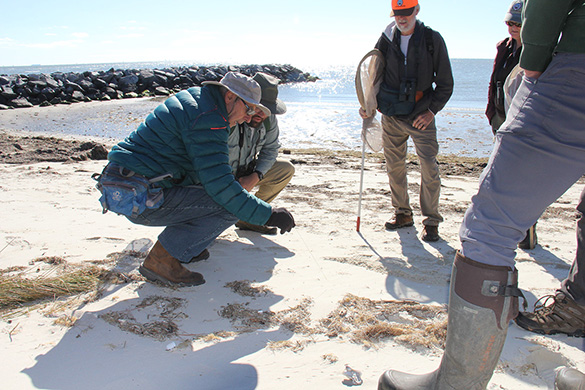
 Department of Conservation and Recreation
Department of Conservation and Recreation
Conserve. Protect. Enjoy.
 Department of Conservation and Recreation
Department of Conservation and Recreation
By Emi EndoPosted December 24, 2023

More than a century ago, the northeastern beach tiger beetle (Habroscelimorpha dorsalis dorsalis) could be found in “great swarms” on beaches along the Atlantic Ocean from Martha’s Vineyard to New Jersey and on beaches on Chesapeake Bay.
But in 1990, as shoreline development, erosion and recreational beach use wiped out populations, the small, agile tiger beetle was listed as threatened under the federal Endangered Species Act. Currently, beaches and shorelines along the Chesapeake Bay are the stronghold for this species.
Renowned tiger beetle expert Dr. C. Barry Knisley, a former biology professor at Randolph-Macon College, led training this year in Mathews County for biologists and stewardship staff from the Virginia Natural Heritage Program on surveying for tiger beetle larvae.
In October, at New Point Comfort Natural Area Preserve and along the surrounding shoreline, Knisley demonstrated how to spot and measure burrows of the larvae. At Bethel Beach Natural Area Preserve, Knisley led an outing in July to show how to differentiate the northeastern beach tiger beetle from other tiger beetle species that could be breeding on the beaches.
Through three different stages of development, the larvae, which have soft bodies and armored head shields, dig vertical burrows in the sand below the high tide line, waiting to ambush prey that passes near the opening. Their small holes in the sand often have telltale castings scattered nearby, tiny clumps of sand tossed out by the larvae as they maintain their burrows.
Being able to locate larvae is important to measure and monitor the populations, and helps to prevent human disturbance from causing them harm. The presence of these ecologically important insects is an indicator of a healthy beach community.
“We must keep a close eye on the health and distribution of the Virginia population of the northeastern beach tiger beetle,” said Ellison Orcutt, lead field zoologist. “In addition to the long-present threats, sea level rise brings additional uncertainty around the resiliency and flexibility of this very specialized species.”
Protecting sandy shorelines where tiger beetles make their home is part of the mission of the Virginia Natural Heritage Program at DCR. Responsible for the ecological management of the habitats of rare, threatened and endangered species, the program maintains several natural area preserves in the Chesapeake Bay and Eastern Shore regions where tiger beetle populations have been documented. Stewards monitor populations on the preserves every year. The locations include:
These preserves offer public access, but please check the guidelines before visiting to help protect the natural resources found there.
The northeastern beach tiger beetle is just one of more than 1,900 natural heritage resource elements (including rare species populations, exemplary natural communities and significant geological features) tracked by the agency’s scientists. As of its most recent rare species list issued in September, the tiger beetle was listed as federally and state threatened, and state imperiled, or at high risk of becoming extinct in Virginia.
Categories
Conservation | Natural Heritage

